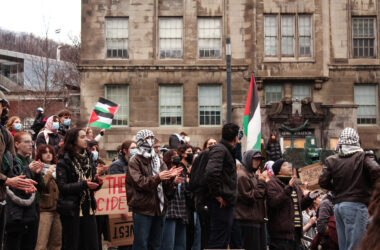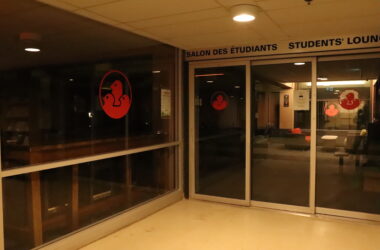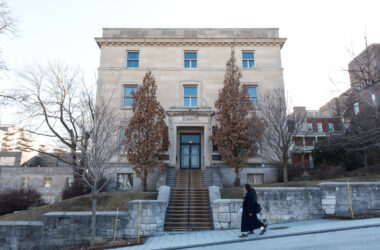 Elisha Lerner
Elisha LernerFollowing the end of the province-wide demonstration against tuition hikes, 14 students occupied the fifth floor of the James Administration Building wearing hoods and masks. According to Fariddudin Attar Rifai, president of the Association of McGill Undergraduate Student Employees, this occupation allegedly occurred around 4:00 p.m.
Soon after, students outside the James Administration Building learned through social media messages that acts of aggression were occurring inside.
“We heard at that point that the people inside were being brutalized, being dragged on the floor, kicked, kneed in the stomach, that kind of stuff,” Joël Pedneault, SSMU’s Vice-president External Affairs, explained.
“We stress that the only aggression that occurred on the fifth floor of the James Administration Building was by security personnel and directed at us,” the occupiers said in a letter written to the McGill Daily.
“In fact, one of us was scratched down his face and strongly hit in the stomach after being thrown and dragged. Others were forcibly expelled. We caused no ruckus, but only acted to protect,” the occupiers’ letter went on to read.
Principal Heather Munroe-Blum addresed this issue in an open email to the public.
“Security personnel were called to deal with the situation. Over the course of a few minutes, they ushered most of the protesters back to the reception area, but a few refused to leave my office. These individuals were carried out to the reception area under protest, where they were then left undisturbed.”
When asked on Friday morning about this event, Officer Jean-Pierre Brabant of the Montreal Police denied having any knowledge of it. “I don’t have any information on the McGill campus. I know that officers were around McGill campus to protect the building itself, but if there was any altercation between officers and rioters … we don’t have anything on [it],” Brabant said.
He explained that those police who were on site gave a report after the protest which only contained information on the four people who were arrested during the afternoon demonstration.
Activity outside
According to Deputy Provost of Student Life and Learning Morton Mendelson, the police were not called by someone from the fifth floor. Munroe-Blum later confirmed that security personnel called the police.
“[At] 4:37, we got word that the police were called. This is when the senselessness began; because it was totally unnecessary to call them, internal negotiations would have been enough,” Rifai said.
In support of those inside, other protestors from the rally encircled the building in an attempt to delay police entry.
“People basically started to move to the Administration Building at McGill to do a support action, a small demonstration, very peaceful,” Pedneault said. “People were wrapping their arms around the building trying to [make] a human chain.” Students from McGill, Concordia, and Dawson were among those present during this demonstration.
“It was a tactic to allow the occupiers inside [to] resolve the issue without police intervention,” Rifai said.
“There were things going on that were of concern and could have been of concern to security,” Mendelson said. “Security are mandated, or certainly allowed, to call the police when they feel there is a threat to people or a threat to property. Those are decisions that have to be made quickly … made on the moment. I don’t know what triggered the decision to do that.”
Police on bicycles arrived on the scene. Both the police as well as the students demonstrating were aggressive towards one another. The police turned away, after a few minutes.
Around 5:00 p.m., approximately 100 police in riot gear arrived through the Milton and Roddick Gates. Montreal Police spokesman Ian Lafrenière, who personally witnessed the confrontations, stated that the riot squad was deployed in response to people throwing boat flares shot from a pistol, along with other objects, at the police. The CBC quoted Lafrenière describing those demonstrating as “just a small group of individuals trying to take advantage of the situation to do something stupid.”
“Once we call the community police, we have no control over the policing measures that are used. As I understand it, no one called the riot squad, but the police have to use their judgment about their own ability to control a situation to prevent harm from happening,” Munroe-Blum explained when she spoke with members of campus media on Monday.
The riot police disbanded the line of students around the building and formed a chain that blocked entrance into the building. Students in front of the police line were pepper sprayed. The police then chased students and threatened them with their batons.
“I saw a police officer kick a protester to the ground and kick him repeatedly in the stomach,” U3 arts student Hilary Brown said. “As the riot police charged down the large steps, I saw them push photographers and other protesters down the hill.”
“I was standing right here filming police helmet numbers and then all of a sudden they started beating us with their shields,” Daniel Seggy, U0 arts student, said. “I got pepper sprayed and then the tear gas came out. They pushed us down those big stairs, which is obviously dangerous. There was repeated trampling and pepper spraying. It was awful.”
During this time some students managed to find a way into the first floor of the James Administration Building where they held a sit-in. According to Pedneault, “[they were] saying they weren’t going to leave until the people on the fifth floor were released.”
Mendelson later questioned the claim that the occupiers were being held, stating, “There were no students being detained in the James Admin. Building by police or by the university. We wanted the students to leave. The students were refusing to leave.”
Students involved i
n the sit-in were forcibly removed by McGill security.
“[McGill security] were concerned about the safety of the situation, and the student [who was refusing to leave her office]was taken out of the office and then left in a public area with his fellow students, we don’t know if they were students. Some may not have been students,” Mendelson said.
Soon after, riot police charged and dispersed the crowd while more riot police arrived from the Milton Gates. Trapped from the north and west of campus, students were forced into the McConnell Engineering Building. Many ran to wash tear gas from their faces. Police then barricaded McConnell Engineering, trapping at least 20 students inside for several minutes.
The police then allowed students to leave the Engineering Building, but acted aggressively and indiscriminately, pushing students who were leaving classes from McConnell Engineering, as well as those involved in the protest.
Just before 5:30 p.m., police in full riot gear had blocked entrance to McGill’s campus from the Milton Gates, setting up lines along the east and west sides of Milton and University.
Protestors chanted, “It’s our campus!”
Around 6:00 p.m., police banged batons against their shields and charged into the group of onlookers gathered along Milton near the intersection. The charge along Milton continued past Lorne Avenue, at which point the crowd had mostly dispersed.
The police left the McGill campus by 7:30 p.m. at the latest. The students occupying the fifth floor of the building negotiated their release with Provost Anthoni Masi and Deputy Provost Mendelson. It was agreed that no names would be taken, no disciplinary procedures would be pursued, and no arrests would be made.
Some protestors and bystanders in the area sustained injuries as a result of police actions. Greg Mikkelson, an associate professor in McGill’s department of philosophy and the school of environment, was on his way to pick up his daughter from McGill’s daycare when police clubbed him with a baton and pepper sprayed him.
Ian Macphee, U2 English, and his roommate watched two policemen aggressively push a girl to the ground. Macphee’s roommate tried to help the girl stand up, and upon seeing the policemen closing in on the roommate to push him too, Macphee stood between the police and the two students.
“I stepped in front of them with no look of serious aggression, I made a motion of breaking up a fight, and out of nowhere I was hit in the face,” he said. “Maybe five or 10 seconds later, the tear gas went off right in front of my face. After that I was pretty messed up.”
Later that night, Macphee had to go to the hospital to get stitches on his lip. Due to the shock of the experience, he did not properly rinse the tear gas from his eyes and on Friday night returned to the hospital and was diagnosed with a chemical burn in the eyes.
Immediately following the commotion, SSMU President Maggie Knight tweeted to let students know that they could find support at the SSMU Building. Over 30 students received support from the student society as well as first aid services from M-SERT.
“One girl came in with really bad pepper spray, she had to get her eyes washed for [about] an hour and a half,” Emily Yee Clare, VP University Affairs said. “Lots of students came to the office, they sat there and comforted each other.”
Most students remain in shock over the force used by the riot police.
“I guess a lot of people had thought that in a country like Canada this would never happen,” Pedneault said. “In many countries police are just not allowed on university campuses because it reminds people of a past era of dictatorship and authoritarian rule, and that’s something that was definitely in the back of people’s minds [Thursday].”
Responses
On Friday afternoon, over 50 concerned faculty and students waited outside the James Administration Building from around 1 p.m. to 5 p.m. to deliver a letter drafted by McGill Faculty Labour Action Group (MFLAG) and talk to one of the senior administrators.
“[The letter] is asking for a full and public inquiry into the events of what happened [Thursday]night. It’s asking for the university to put in formal procedures and criminal reporting procedures for all faculty and students abused by cops and security,” Gretchen King, PhD candidate in the department of communications, said. “We’re also asking for legal recourse and resignation of all the administration that approved the police presence on campus last night.”
Following the collection of signatures, MFLAG members were denied entry into the James Administration Building and were told by security that they needed to have an appointment to enter. Offers by a security guard, as well as from VP Finance and Administration Michael Di Grappa’s secretary, to deliver the letter were turned down by the group, who were demanding that an administrator personally speak with the group.
Around 4:30 p.m., the group decided to accept the offer to send two delegates up to Munroe-Blum’s office. The delegates, McGill student Amber Gross, U2 philosophy and history, and Professor Adrienne Hurley returned shortly with a message relayed from the head of the University. Munroe-Blum expressed “distress” at the situation, but had “someone coming in from out of town” and did not have time to meet with the group.
Munroe-Blum addressed the McGill community on Friday afternoon via email, announcing that an independent investigation will be carried out by Dean of Law Daniel Jutras. The principal will receive and make public the results of the investigation on Dec. 15.
SSMU executives also sent an email to students later that evening, which called the police reaction “disproportionate” and detailed a number of resources for students to get help, including SACOMSS and McGill Nightline.
Some faculty members question whether the riot police had the right to be on campus in the first place.
“[The reason] I’m really profoundly upset is that there were policemen inside the campus … This is a space where y
ou can’t bring the cops in,” Daviken Studnicki-Gizbert, history professor, said.
However, Studnicki-Gizbert outlined the situation as a possibility for increased dialogue between different groups at McGill.
“What seems to be on the table now [with the administration] is this idea that the university has to have a conversation with itself, especially with regards to what happened last night,” he said. “It has to have an open conversation with all the different people and groups that constitute the university community. I think that’s an opening and an opportunity that we shouldn’t miss.”









Pingback: Riot Police at McGill | Kyla Mandel Portfolio